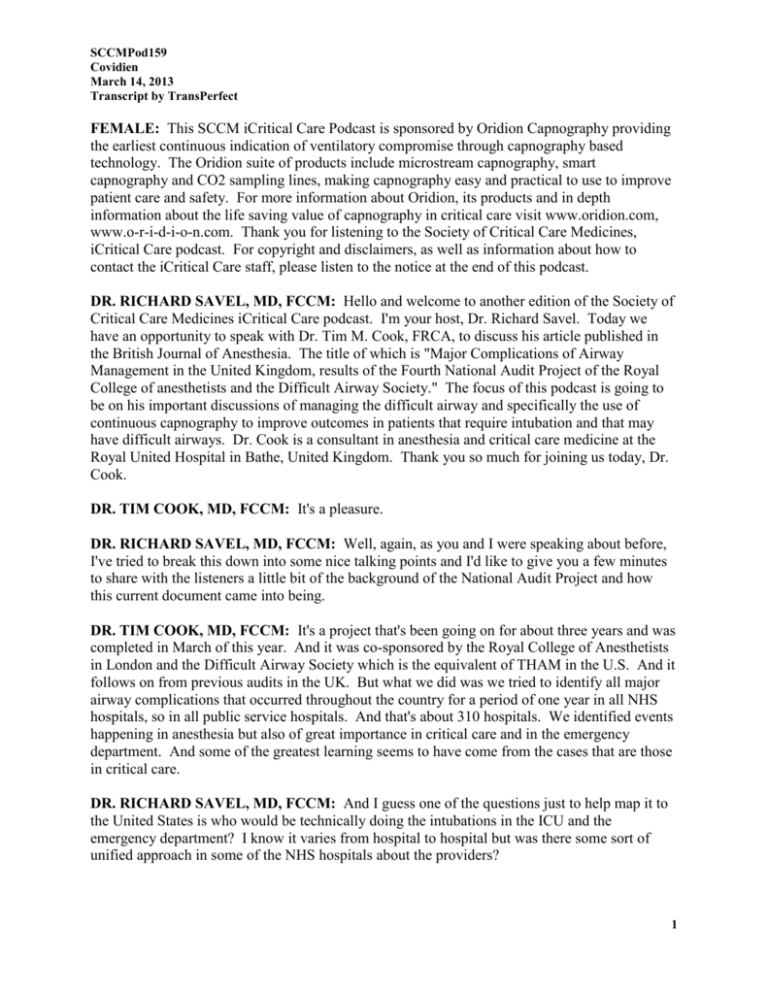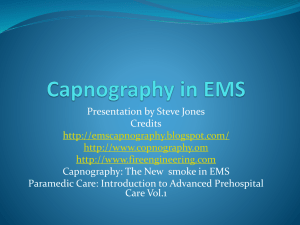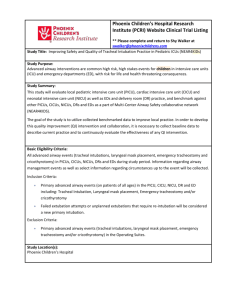
SCCMPod159
Covidien
March 14, 2013
Transcript by TransPerfect
FEMALE: This SCCM iCritical Care Podcast is sponsored by Oridion Capnography providing
the earliest continuous indication of ventilatory compromise through capnography based
technology. The Oridion suite of products include microstream capnography, smart
capnography and CO2 sampling lines, making capnography easy and practical to use to improve
patient care and safety. For more information about Oridion, its products and in depth
information about the life saving value of capnography in critical care visit www.oridion.com,
www.o-r-i-d-i-o-n.com. Thank you for listening to the Society of Critical Care Medicines,
iCritical Care podcast. For copyright and disclaimers, as well as information about how to
contact the iCritical Care staff, please listen to the notice at the end of this podcast.
DR. RICHARD SAVEL, MD, FCCM: Hello and welcome to another edition of the Society of
Critical Care Medicines iCritical Care podcast. I'm your host, Dr. Richard Savel. Today we
have an opportunity to speak with Dr. Tim M. Cook, FRCA, to discuss his article published in
the British Journal of Anesthesia. The title of which is "Major Complications of Airway
Management in the United Kingdom, results of the Fourth National Audit Project of the Royal
College of anesthetists and the Difficult Airway Society." The focus of this podcast is going to
be on his important discussions of managing the difficult airway and specifically the use of
continuous capnography to improve outcomes in patients that require intubation and that may
have difficult airways. Dr. Cook is a consultant in anesthesia and critical care medicine at the
Royal United Hospital in Bathe, United Kingdom. Thank you so much for joining us today, Dr.
Cook.
DR. TIM COOK, MD, FCCM: It's a pleasure.
DR. RICHARD SAVEL, MD, FCCM: Well, again, as you and I were speaking about before,
I've tried to break this down into some nice talking points and I'd like to give you a few minutes
to share with the listeners a little bit of the background of the National Audit Project and how
this current document came into being.
DR. TIM COOK, MD, FCCM: It's a project that's been going on for about three years and was
completed in March of this year. And it was co-sponsored by the Royal College of Anesthetists
in London and the Difficult Airway Society which is the equivalent of THAM in the U.S. And it
follows on from previous audits in the UK. But what we did was we tried to identify all major
airway complications that occurred throughout the country for a period of one year in all NHS
hospitals, so in all public service hospitals. And that's about 310 hospitals. We identified events
happening in anesthesia but also of great importance in critical care and in the emergency
department. And some of the greatest learning seems to have come from the cases that are those
in critical care.
DR. RICHARD SAVEL, MD, FCCM: And I guess one of the questions just to help map it to
the United States is who would be technically doing the intubations in the ICU and the
emergency department? I know it varies from hospital to hospital but was there some sort of
unified approach in some of the NHS hospitals about the providers?
1
SCCMPod159
Covidien
March 14, 2013
Transcript by TransPerfect
DR. TIM COOK, MD, FCCM: In the NHS, it will always be a physician that is intubating, so
an intensive care doctor. Usually that will be what we call a consultant in most circumstances.
But out of ours, it's more likely that the physician performing intubation will be still in training
and most the intensive cares are manned by intensivists whose original specialty is anesthesia.
But there are some originators, physicians and emergency physicians.
DR. RICHARD SAVEL, MD, FCCM: And in the emergency room as well, those will mostly
be emergency room trained physicians or anesthesiologists?
DR. TIM COOK, MD, FCCM: We don’t know completely but we think that about 80 percent
of the intubations in the UK that take place are performed by critical care doctors rather than
emergency physicians. Emergency physicians managing rapid [INDISCERNIBLE] induction in
the UK is evolving and increasing. But a survey that was done concurrently by Professor
Benjamin Bristol identified 80 percent of intubations were done by critical care physicians.
DR. RICHARD SAVEL, MD, FCCM: And how is it set up, just for interest, in terms of
collecting all this data? Was there a centralized Web page that every time somebody had a
difficult airway or was concerned about it they entered it in or how was the determination made?
DR. TIM COOK, MD, FCCM: Yeah, we spent a year setting up the project and getting
permissions from our department of health and various other bodies to carry on the project. We
then identified the local reporter in every hospital and in most hospitals we had a local reporter
for anesthesia for intensive care at the emergency departments, so three local reporters. There's a
strict criteria for cases to be reported to us. So these were high end complications. They were not
simply difficult airways. So these were patients who as a result of problems with airway
management either died or developed brain damage or had to have an emergency surgical airway
of any types. So cricothyroidotomy through to emergency tracheostomy or were admitted into
intensive care. And for those patients who already resident on intensive care, if the event led to
prolongation of their stay. So these were all very serious events. These were not simply difficult
airways. But these were either near missed deaths or in many cases actual deaths.
DR. RICHARD SAVEL, MD, FCCM: And had anything like this ever been done before in
the United Kingdom?
DR. TIM COOK, MD, FCCM: No is the simple answer. We done a similar study which I led
for looking at major complications of central [INDISCERNIBLE] block using the same methods.
But in terms of looking at the airway and particularly identifying problems not only in anesthesia
but in intensive care in the emergency departments I think the answer is no and I think
realistically the answer is in terms of the breadth of this project it's not been done worldwide up
until this project.
DR. RICHARD SAVEL, MD, FCCM: Well I thought we could move on to the next talking
point which was incredibly fascinating and very results-rich where you focused in on what you
have observed. And if you'd like to take the next few minutes and discuss some of these
important observations, that would be great.
2
SCCMPod159
Covidien
March 14, 2013
Transcript by TransPerfect
DR. TIM COOK, MD, FCCM: Okay. There are potentially quite a lot of results and it
requires a bit of filtering to dual out the important results. One of the key points was that
although about 20 percent of the events reported to us came from the intensive care departments,
they did account for almost 50 percent of the deaths. So when an event occurred to a patient who
is on intensive care, perhaps predictably, it was much more likely to end in brain death or death,
so brain damage or death. So in anesthesia we had 130 cases reported to us with a 14 percent of
those leading to death or brain damage. Whereas in intensive care, more than 60 percent of the
events ended up with a patient either dead or brain damaged. The sorts of patients this happened
to, there were more males than females. They were generally reasonably young. They were
often patients who had multi-organ failure or certainly had other organ system support and about
half the patients were requiring more than 60 percent oxygen at time of the event. So they are
clearly ill patients to start with. Another notable feature was almost half the patients were obese.
In the UK during the period of time that we collected the data, the prevalence of obesity or BMI
greater than 30 was around 24 percent. So it was twice as often as in the general population
obese patients had these complications and obese patients on ITU who suffered these events had
a worse outcome than patients who were not obese. The types of events that happened fell
largely into two categories. First category was problems at intubation and those problems were
either failed or delayed intubation or a significant number of misplaced tubes, particularly soft
tube intubations which we'll come back to later, perhaps. And then the second group of
problems was the loss of an airway in a patient who was dependent on it. And the vast majority
of those are tracheostomies. So there are a few endotracheal tubes that fell out, all replaced, but
the vast majority were tracheostomies. And almost half of the ITU deaths were caused by
displacement of a tracheostomy inadvertently.
DR. RICHARD SAVEL, MD, FCCM: So there's a couple issues that come up right away in
terms of comparing with standard care in the United States. And in some of the larger city
hospitals patients may have a tracheostomy and not be in an intensive care unit and that's one
thing. The second thing I was going to ask you about are people who needed to be intubated on
the floors and then come to the ICU and then the third thing is that sounds like a lot of problems
with the tracheostomies falling out and, again, in patients who may have non-fresh trachs. It
should be reasonably straightforward to put them back in but if you wanted to expound upon
that, I think that's a super important area.
DR. TIM COOK, MD, FCCM: Okay. There's a few questions there. The first point about
patients being intubated on a ward and coming to—on the floor in the ward coming to intensive
care of patients having trachestomies on the ward, there may have been problems with those
patients but we would not have picked them up. The remits of our project was anesthesia,
patient in critical care and patients in emergency department. So we had to limit the project, and
those were the limits. So there are likely to have been more events that happened that we did not
identify, but I can't put a number on those. The problem with the tracheostomies, to put it in
context with the 133 anesthesia events, we had 36 intensive care events, 60 percent of which led
to death. Our estimates are that we probably captured only one quarter of the true number of
events. So while we identified 22 episodes of death and brain damage on intensive care, we
think it is probably more likely that in the one year period we studied there were approximately
3
SCCMPod159
Covidien
March 14, 2013
Transcript by TransPerfect
100. There were a few—the typical case that would happen in terms of tracheostomy
displacement, some of them were freshly performed, some of them had been reasonably mature,
so in for several days but typically in for three or four days. And often in an obese patient
perhaps with a standard tracheostomy, we had some patients who had originally had a phalange
or longer tracheostomy adjustable phalange tracheostomy then would change to perhaps a
speaking tube which have to be shorter. And those tubes then displace often when they were
being turned or when they were moving themselves during a sedation hold, and the tracheostomy
became displaced. There was a notable finding that there was a delay in diagnosis of the
displacement of the tracheostomy. Very few of these patients had capnography in place, and we
identified that a considerable majority of all the events and particularly the displaced
tracheostomies. So it delayed diagnosis because capnography was not in use, and we made a
recommendation that capnography should be universally applied to patients in critical care.
DR. RICHARD SAVEL, MD, FCCM: So this is perhaps the key point of the whole podcast,
so I'm going to rephrase it for you and let you talk about it some more. You're not talking about
a situation where your supervising me doing an intubation that the capnography—well, A, it
would hopefully prevent me from if I get into the esophagus knowing that quickly but you're
talking about more about a nurse or somebody being notified that somebody's tracheostomies
fallen out and an alarm would go off with the continuous capnography, right? Am I
understanding you correctly?
DR. TIM COOK, MD, FCCM: Yes. Both events are covered by our recommendation for
capnography. If I take the first point first, there were—the paper says three but there was in fact
on further scrutiny we had identified a fourth case of intensive care soft tube intubation. Three
of those patients died. In all cases the soft tube intubations occurred without capnography being
in place. Most frequently the intubation being performed by a junior—in terms of a junior
anesthetist. Those deaths would almost certainly have been preventable had capnography been
in place. The tracheostomy displacements again, it was almost universal. The capnography was
not in place when the tracheostomy displaced. Some patients the problem was identified because
the ventilator was alarming. In other patients it may have been spontaneously. It was not
identified until marked hypoxia and in a couple of cases cardiac arrest. So either surgical
emphysema or cardiac arrest being the, they would identify the nurses to the event whereas we
believe that an appropriately alarmed capnography would identify the problem pretty much
immediately.
DR. RICHARD SAVEL, MD, FCCM: And I guess just, again, to flush that out a little bit, my
understanding, my background is internal medicine, critical care, but I spent some time in the
operating room as part of my fellowship and that this continuous capnography is more of a
standard of care in operating rooms than in intensive care units. And if you'd like to talk a little
bit more about maybe how it ended up that way and why you think things should change and
how we should go about doing that, that would be great.
DR. TIM COOK, MD, FCCM: You're absolutely right. Capnography has been a standard of
care for any anesthesia in the operating rooms for probably 15 years. And most of the colleagues
that we reviewed these cases with we all agreed that were capnography not available when we
4
SCCMPod159
Covidien
March 14, 2013
Transcript by TransPerfect
took somebody to the OR, we would not proceed with anesthesia, whereas, the circumstances
appear to be very different both in the emergency department and in ITU. Were capnography is
not in the UK standard, we estimate that about 25—or we believe from previous surveys about
25 percent of ITU's in the UK use continuous capnography while 40 percent of them use it for
intubation. Now this is slightly perverse. We would never anesthetize a patient in the operating
rooms and then take off their capnograph for the rest of the case. It would be a perverse thing to
do. And of course the intensive care patients are not looked after by an anesthesiologist or an
intensivist but bedside care is delegated to a nurse who does not have the same anesthetic or
airway skills perhaps. So we do appear to be applying different standards, and our paper has
promoted much discussion in the UK. Already we see a change in practice in quite a few
hospitals and I would hope within a year capnography for patients dependent on an artificial
airway in ITU will be the standard.
DR. RICHARD SAVEL, MD, FCCM: Well and hopefully what this will generate some
discussion here in the United States as well. I guess I remember when they were first bringing
this up to me to talk with you about I thought I understood it and said, no, we already have—we
use capnography as part of our intubation kit. We do have this color metric analysis. But you
specifically don’t feel that's enough, and if you'd like to talk about that, I'd really appreciate it.
DR. TIM COOK, MD, FCCM: Our view was that the majority of these cases—if we consider
a period of time depending on artificial airway in intensive care a bit like anesthesia with
induction and maintenance and then extubation. The vast majority of these cases occurred
during the maintenance phase of intensive care which of course is the longest period of time.
But these were unexpected events usually [PH] to cure tube displacement and it's likely—so a
color metric device might be used at the time of intubation say, yes, I’m in the trachea, not the
esophagus and then it's really served its function, and it's removed. Whereas continuous
waveform capnography is—appears to be more suited to continuous monitoring. One wouldn't
put on a pulse [INDISCERNIBLE] and say the saturation is 92 percent, then take it off and come
back an hour later to look at it. And while of course the capnograph may have many other uses
in intensive care. The particular use that we're talking about is simply using it as a measure of
potency of the airway. I spoke with a germist in the UK briefly about this and I—there's a lady
that's been on our intensive care for approximately 40 days, and I explained to him that by using
continuous waveform capnography we had monitored every single breath that that lady took for
the 40 days that she'd been there. Every breath had been indicated by a white square wave going
up and down on her bedside monitor. And I think it's that that's necessary if these reasonably
infrequent but very important events are to be prevented. If I may, I put in context when I say
reasonably infrequent and in that full project for anesthesia we did a national survey to identify
how many anesthetics are given in the UK. And that figure came out as 2.9 million general
anesthetics given in the UK. And then if we put our numerator in of the number of deaths during
anesthesia and bring damage of 21. And we end up with an approximate instance of death or
brain damage during anesthesia of about one in 180,000 cases, so an airway death during
anesthesia about one in 180,000 cases. In intensive care we can use other statistical data from
the department of health statistics. And that tells us a bit about a 50,000 patients were intubated
and managed with an advanced restricted care in the same period. So the 22 deaths that we have,
deaths and brain damage that occurred on ITU in that cohort of 48,000 patients represents
5
SCCMPod159
Covidien
March 14, 2013
Transcript by TransPerfect
approximately a 70 fold greater incidents of death and brain damage than during anesthesia. So
the rates are roughly one in 180,000 anesthesia and one in 2,700 in intensive care with the
emergency department falling between those rates.
DR. RICHARD SAVEL, MD, FCCM: No, and as you were talking you reminded me because
my—a lot of my mentors in fellowship were anesthesiologists and they explained to me that sort
of the ICU is not the place to learn—it's not the best place or the most user friendly place to learn
how to intubate and that's why we spent some time in the operating room because sort of
everything stacked against you if you're seeing a patient who's deteriorating from a respiratory
standpoint and then you have to intubate them. It's a race. It's not like this is a healthy patient
who happens to need their airway secured. And I wanted to make two important points just to
reiterating what you said. The first was that as you point out that the failure to use capnography
contributed to 74 percent of cases of death or persistent neurological injury in your study and this
was emphasized in your paper and the press releases, and I wanted to really make that a very
clear point. And the second is more of a question to you is let's pretend this promulgated within
the United States. This is equipment that hospitals are already using in operating rooms so that if
hospitals needed to expand them to the ICU's and the emergency rooms it wouldn't be that—they
already have this kind of equipment in their hospitals, right?
DR. TIM COOK, MD, FCCM: Absolutely. So you're absolutely right on the number. We
were quite conservative in the review panel in determining whether we thought a death or an
event could have prevented or death prevented by using capnography. So we would say that
probably I would say at least 80 percent of the events on ITU should have been identified early
and therefore either mitigated or prevented by use of capnography. The equipment is available.
Lots of people will put up technical reasons as to why it can't be used. But we've been using
capnography on our intensive care only for about two years, but every patient who comes to the
intensive care, the nurses now automatically put capnography before they're intubated that makes
it ready for intubation and then it's used throughout their care. And I have never been called by
them to say there's a problem with the capnography. We know that occasionally we get water
filling the lead from the capnograph to the monitor, and we need to be careful to prevent that.
But there's people who say that too many technical problems have not worked in the unit where
the nurses are familiar with doing it, and they do it in the same way as they do the many rules
that they do. If I could pick up on one point you made about intensive care being—it actually
being a hostile place to intubate. I think that's absolutely right. And I think of course there are
many reasons why the patients may have events on intensive care, have worse outcome than in
anesthesia. So they're sicker. They often have [INDISCERNIBLE] failure. The light may be
different. The positioning may be different. It may be difficult to get the patients. All sorts of
reasons why it's a hostile environment. But to my mind that makes it even more important that
the simple monitors that are already available in hospitals relatively modest cost should be used
on these patients. In the UK the setup cost for putting capnography monitoring into an intensive
care bed is about $3,000. Once it's in place it costs less than $4 per day per patient. So the cost
is compared to the rest of intensive care are very modest.
DR. RICHARD SAVEL, MD, FCCM: And as you point out, it's completely non-invasive and
really as you say one or two cases like this, A, if they're preventable we should be trying to
6
SCCMPod159
Covidien
March 14, 2013
Transcript by TransPerfect
prevent them and, B, if we can prevent them in a completely non-invasive fashion, then it's you
know why aren't we doing this would be what national leaders would say, right?
DR. TIM COOK, MD, FCCM: I agree.
DR. RICHARD SAVEL, MD, FCCM: I wanted to give you an opportunity to talk about one
or two last points, and then we'll conclude. One separate from the capnography. One is you
pointed about some staffing issues, and the second is I wanted to ask you about things like
backup plans and use of equipment like the glide scope. Could one argue that this could be an
also part of a comprehensive approach to improve things?
DR. TIM COOK, MD, FCCM: There are many things that we looked at. We found that
compared to anesthesia events in both the emergency department and critical care were much
more like to occur after hours. The events were more likely to be handled by quite junior
medical staff. So our residents may be quite junior, may have only had two or three years
experience post qualification as a doctor. And through no fault of their own, these doctors may
not be equipped to handle these events. We think that they can be supported, both the time of
intubation. Intubation it should be a more senior doctor performing on intensive care. But one
of the things we put in the back of our—of the report which is available on the college Website,
first, A, intubation checklist. The checklist is increasingly prevalent in much of medicine. And
we think that this checklist, or a similar one, may add value at the time of intubation because it
stops things being forgotten and it stops problems happening. I use it every day when I intubate
a patient on intensive care now. We also developed some algorithms for management of
predictable problems on intensive care. So we have algorithms in the report for unexpected
[INDISCERNIBLE] tube displacement and unexpected tracheostomy displacement. Both
algorithms have one pathway for residents to follow and then one to manage greater problems
that can be followed by a more senior doctor if they attend. So I think these problems are
predictable. In every intensive care somebody's tracheal tube will fall out this year, and
someone's tracheostomy will fall out this year. Most of the time it's probably picked up quite
quickly and managed quite straightforwardly. But speaking to a lot of intensivists in the United
Kingdom, most have tales to tell about the tracheostomy that fell out and that wasn't managed
well, and the patient died. And since then they changed their practice. So I think our project
gives people the opportunity to actually to focus a bit more on the airway and these preventable
complications and preventable deaths and prepare themselves for it, prepare themselves as
institutions and prepare themselves as individuals so the right equipment is there, that the airway
cart is available in all intensive cares, the fiber scope is available in all intensive cares, standard
operational procedures are available, checklists are available, some education takes place of
nurses and residents and more senior doctors in appropriate management and of course the
monitoring is there to detect these events. If all those things happen, and those are forms of
events what I call institutional preparedness and then the doctors themselves have to make sure
that they are prepared, that there's personal preparedness to deal with these problems, that they're
familiar with the SOP's, that they're familiar with the capnographs and they're familiar with the
particular problems of the individual patients they're looking after on a particular shift.
7
SCCMPod159
Covidien
March 14, 2013
Transcript by TransPerfect
DR. RICHARD SAVEL, MD, FCCM: Well, Dr. Cook, I'm really very grateful that you could
find some time to be with us today. These difficult airways are some of the most dramatic and
traumatic situations that intensivists can find themselves in, and yet it's part of what we need to
be able to do. And I think some of the important points that your very important document made
were for institutions to optimize staffing, potentially that this concept of having the most junior
people on off hours involved, if it is occurring perhaps there are ways that that should be
mitigated, that there should be a structured approach to this at all times and that you should be
thinking what if the next step fails, what if I can't get it now, how am I going to proceed and
coming up with the thought leaders at the institutional level to come up with the best approach
for that hospital. And then finally, as you mentioned, that a completely non-invasive technique
with using continuous capnography, as you point out in your important study, that contributed to
74 percent of either death or persistent neurological injury. This is equipment that all hospitals
are using in their operating rooms already and that with physician champions and clinician
champions this kind of equipment can be promulgated out to intensive care units and emergency
rooms to simply save lives, correct?
DR. TIM COOK, MD, FCCM: Indeed. Absolutely.
DR. RICHARD SAVEL, MD, FCCM: Thank you so much, Dr. Cook. Have a great day.
DR. TIM COOK, MD, FCCM: It was my pleasure.
DR. RICHARD SAVEL, MD, FCCM: This concludes another edition of the Society of
Critical Care Medicines, iCritical Care Podcast. Please check out our Website at
www.sccm.org/icriticalcare for more information as well as access to over five years of archived
podcasts. For the iCritical Care podcast, I'm Dr. Richard Savel.
FEMALE: This SCCM iCritical Care Podcast is sponsored by Oridion Capnography providing
the earliest continuous indication of ventillatory compromise through capnography based
technology. The Oridion suite of products include microstream capnography, smart
capnography and COT sampling lines making capnography easy and practical to use to improve
patient care and safety. For more information about Oridion, its products and in-depth
information about the lifesaving value of capnography in critical care visit www.oridion.com,
www.o-r-i-d-i-o-n.com. The iCritical Care podcast is copyrighted material and all rights are
reserved. Statement of fact and opinion expressed in this podcast are those of authors and
participants and do not imply an opinion on the part of the Society of Critical Care Medicine or
its officers or members. Your host is the Society's associate editor for podcasts, Richard Savel,
MD, FCCM. Dr. Sevel is the medical co-director of the surgical intensive care unit at
Montefiore Medical Center in New York City practicing under the leadership of Vladimir
Kvetan, MD, FCCM. To contact the editorial staff of the iCritical Care podcast with questions,
comments or ideas, please email iCriticalCare@sccm.org or info@sccm.org.
8






